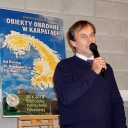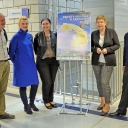The popular-scientific conference “Defensive buildings in the Carpathians. From the Dacians to the Confederation of Bar” was an unusual event which took place on October 20, 2018, in the walls of our Alma Mater, in the rooms of the LUT Library. The organisers of the whole project were: the Lublin representatives of the Carpathian Society (TK), the Library of the Lublin University of Technology, the Institute of Computer Science of the LUT and the Academic Forum Foundation. His Magnificence prof. dr hab. inż. Piotr Kacejko, Rector of the LUT, took the honorary patronage of the conference, and TVP3 Lublin, Polish Radio Lublin, Radio Centrum and the Forum Akademickie monthly were the media patrons.
The conference, which was attended by about 65 people, was aimed at popularising knowledge about various forms of defense constructions in the Carpathians over the period of nearly 2000 years. Both the results of scientific research and observations of contemporary hikers partial to walking in the Carpathians were presented. The whole undertaking included three thematic strands: a series of lectures and presentations, a photographic exhibition and a display of professional 3D scanning equipment used to digitise museum artefacts and archaeological objects.
In the lecture part covering ten themes, the participants were able to take a look at early migrations through the Carpathians (Stanisław Kryciński, TK Warszawa) or the remains of the proud Dacians conquered in 106 AD by Emperor Marcus Ulpius Trajan (Prof. Krzysztof Jaworski from the Institute of Archeology, University of Wrocław) as well as get to know the contemporary image of the largest Roman fortress in Porolissum (Andrzej Wielocha, TK, Warsaw) and its history until the Romans were evacuated from the Dacia province, which Emperor Aurelian ordered and carried out in the years 271-272 AD. The early fort called the “Troy of Trzciniec”, located near Jasło and settled continuously from the Bronze Age to the early Middle Ages, as well as the recent “Archaeological Museum of the Carpathian Troy” was introduced by Tomasz Leszczyński – head of the Archaeological Department of the Museum Podkarpackie in Krosno. Professor Michał Parczewski, representing the Institute of Archeology of the University of Rzeszów, presented an original theory regarding the distribution of fortified tribal settlements (8th-10th centuries), which according to him were a reflection of defensive thought that respected the military superiority of the enemy. Such strongholds were located outside the area of open settlement and constituted well hidden places of escape and shelter for indigenous people. It was also possible to learn the structural solutions of castles built on the northern slopes of the Carpathians from Przemyśl to Cieszyn (thanks, again, to S. Kryciński).
Three papers were devoted to defence facilities in the Carpathians in Romania. Monastic strongholds of Moldavia and Wallachia lost in the deep and inaccessible Carpathian valleys presented by Aleksander Dymek from the Kraków branch of TK. Jerzy Montusiewicz, professor of the LUT and a member of the Lublin branch of TK, presented unique on the world scale fortified churches, built and continually expanded over the period from the 13th to the 17th century by the so-called Transylvanian Saxons, which were built to protect the population from the invasions of Tatar, Turkish and Vlach bands. In the second speech, he presented a lecture on the “Oltenian kules”. At the beginning of the nineteenth century, these defensive buildings were put up by less affluent boyars in the form of well fortified houses characteristic of the western part of Wallachia (kule is the Turkish for ‘tower’). At the end of the conference came a presentation regarding the fortified camps of the Bar Confederates, located in the Low Beskids. The paper was prepared by Maciej Śliwa (a sightseeing expert from Kraków), but as he could not come to Lublin it was presented by Marian Kozłowski from Jasło.
The conference was complemented by a photograph exhibition including 40 pictures taken by the speakers. The photographs were displayed in the Library Gallery of the Lublin University of Technology, and now can be viewed in the digital version on the Library’s website under the “WYSTAWY WIRTUALNE” tab. A special complement to the conference was a demonstration of the 3D digitisation process of museum objects using scanners operating in laser and structural light technology, prepared by staff members of the laboratory “Lab 3D” of the Institute of Computer Science at the LUT, dr Marcin Barszcz and dr Krzysztof Dziedzic. During the show, many digital 3D models were presented from Poland, Uzbekistan and Kazakhstan.
The venue of organising the conference turned out to be excellent and the participants, most of whom were at the Lublin University of Technology for the first time, liked it very much. The introduction of a humanity strand into the walls of a technical university will also have a positive effect on the engineering environment.
Jerzy Montusiewicz

